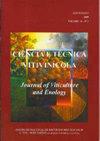Evaluation of the cost-effectiveness of grid-connected photovoltaic solar energy in wineries
IF 0.9
4区 农林科学
Q4 FOOD SCIENCE & TECHNOLOGY
引用次数: 4
Abstract
The objective of this study was to analyze the cost-effectiveness of photovoltaic (PV) solar energy in wineries. The factors analysed were solar radiation, cost of PV installation, prices in the public electricity grid, size of the winery, power of installed panels, influence of the decreased consumption during weekends, and seasonality in the consumption. The study has been based on the European TESLA project, in which 39 energy audits were carried out in wineries in four European countries. A winery of 30,000 hL/year was characterized as a representative winery. The results showed that seasonality was key in the profitability of the system for self-consumption, related to the optimum power to be installed of PV. It was recommended to install, as an optimal PV power, the stable electrical power that is demanded in the daytime period. Optimizing the installed power of PV panels in the representative winery, the percentage of electrical energy consumption covered by photovoltaic energy varied between 16% and 22%. The percentage of the cost of electric energy covered varied between 18% and 24%, with payback values between 18 years (3.1 peak sun hours of solar radiation -PSH) and 10 years (5.6 peak sun hours of solar radiation - PSH). All the factors involved were analyzed.葡萄酒厂并网光伏太阳能的成本效益评价
本研究的目的是分析光伏(PV)太阳能在酒庄的成本效益。分析的因素包括太阳辐射、光伏安装成本、公共电网价格、酿酒厂规模、安装面板的功率、周末消耗减少的影响以及消耗的季节性。该研究基于欧洲特斯拉项目,该项目在四个欧洲国家的酒庄进行了39次能源审计。3万升/年的酒庄是代表性酒庄。结果表明,季节性是影响系统自用盈利能力的关键因素,与光伏发电的最佳安装功率有关。建议将白天需要的稳定电力作为最佳的光伏电源。优化代表性酒庄的光伏板装机功率,光伏能源所占的电能消耗比例在16% - 22%之间。所涵盖的电能成本百分比在18%至24%之间,投资回收期在18年(3.1太阳辐射峰值太阳小时)和10年(5.6太阳辐射峰值太阳小时)之间。分析了所涉及的所有因素。
本文章由计算机程序翻译,如有差异,请以英文原文为准。
求助全文
约1分钟内获得全文
求助全文
来源期刊

Ciencia E Tecnica Vitivinicola
Agricultural and Biological Sciences-Food Science
自引率
12.50%
发文量
5
期刊介绍:
Ciência e Técnica Vitivinícola (Journal of Viticulture and Enology) is an international journal that publishes original articles, research notes and review articles, written in Portuguese or in English, on the various fields of the science and technology of vine and wine: Viticulture, Enology and Vitivinicultural economy.
 求助内容:
求助内容: 应助结果提醒方式:
应助结果提醒方式:


